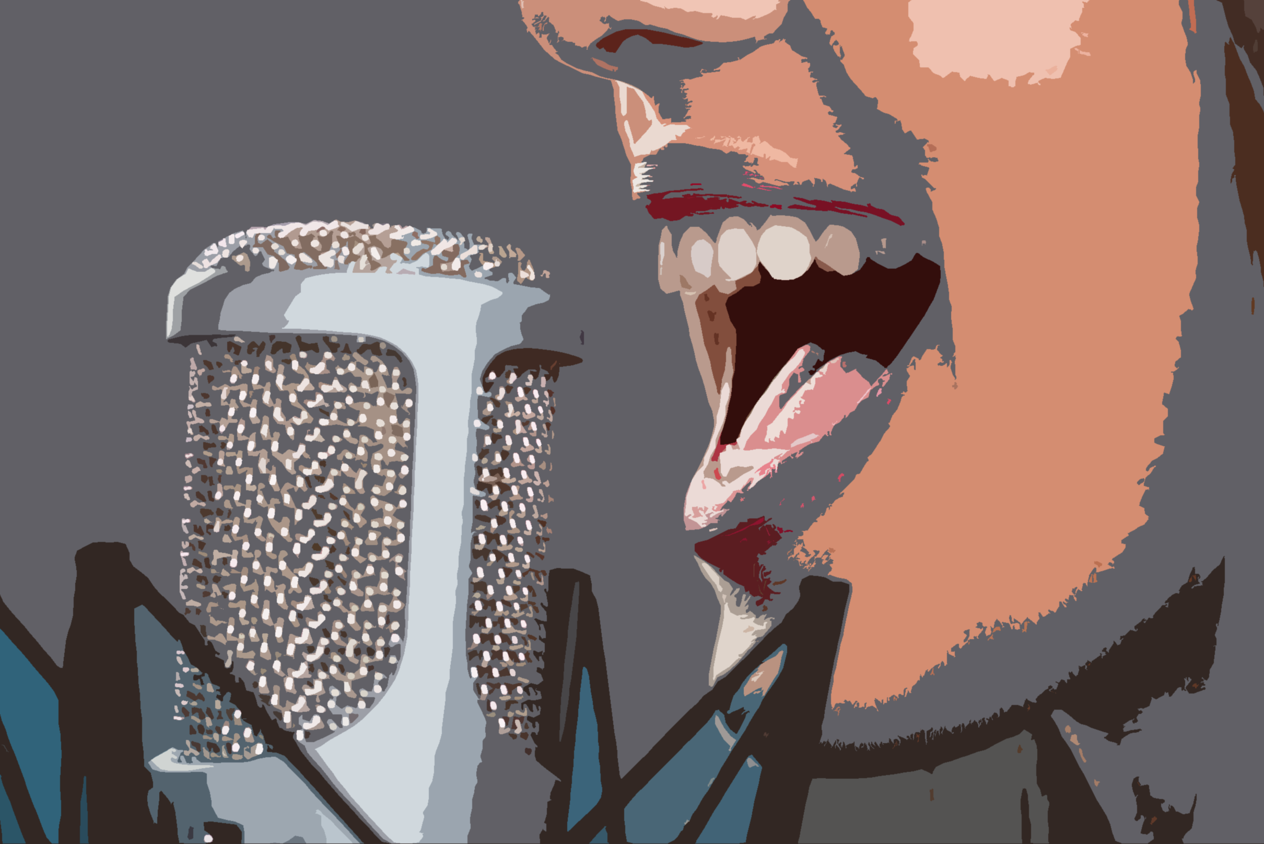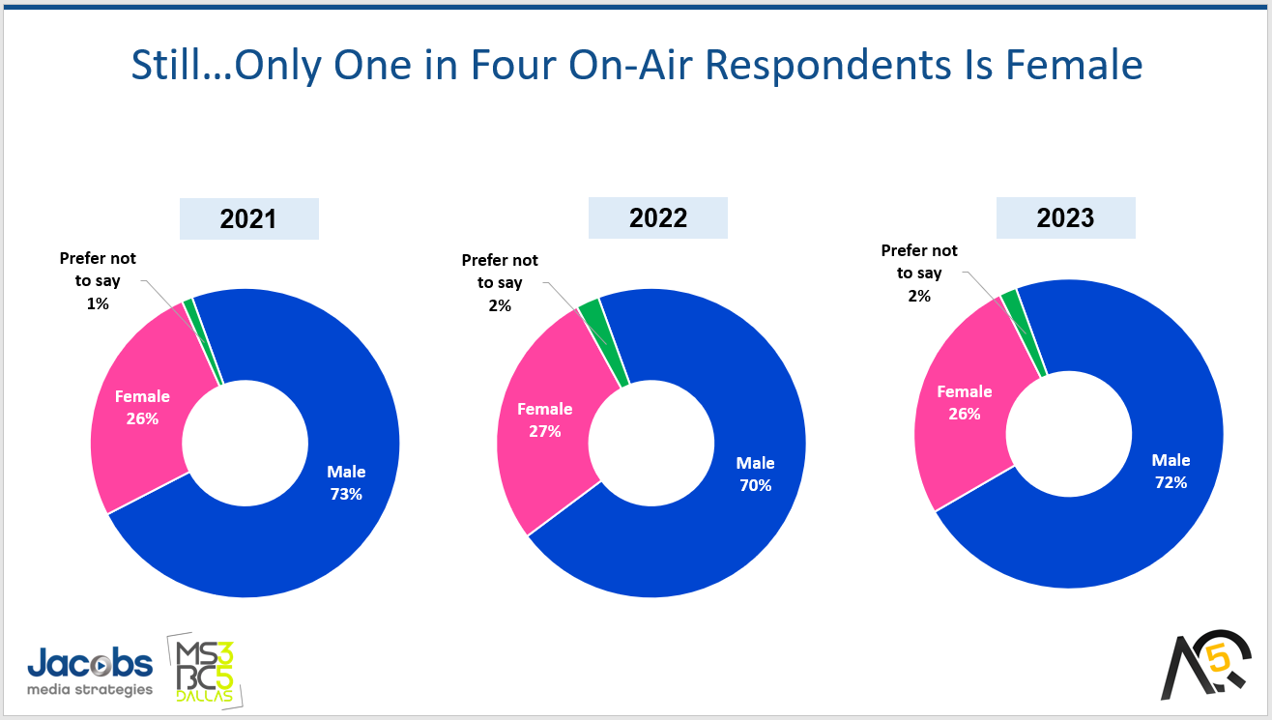
I wrote today’s headline exactly five years ago in 2019. I intentionally wrote it to stir things up a bit (and it worked). A “woman’s place” on the radio dial has long been a contentious issue. And even in 2019, I’m not sure most of us guys had a clear-eyed understanding of exactly how the odds have been systematically stacked against women.
The prior summer, we did our very first AQ study of U.S. air talent on the commercial airwaves. While nowhere near a true census of who’s on the air, it provided a benchmark on key datapoints for talent: How old are they? Do they prefer big markets over medium and small towns? Why did they go into radio in the first place?
And what is the gender makeup of males versus females on America’s music and spoken word stations? Is it even remotely reflective of the population? And what do men and women think of the latter’s opportunity for success behind the mic?
The results may not surprise you. But at the end of this #TBT post, I’ll be back to update our “radio census” by gender to determine just how far we’ve come – or haven’t. – FJ
March 2019
The headline of today’s post alone ought to generate some raised eyebrows. But the fact is, this question is asked a lot in media circles.
And the fascinating thing about this bold query is how different media verticals view the battle of the genders through different lenses and filters.
Let’s start with voice, the fast-rising platform occupying more and more gadgets. They’re the “assistants” we’re talking to more and more in our cars, in our kitchens, and our bedrooms. Alexa, Cortana, Google Voice, Siri, as well as the voices that occupy our cars, are becoming parts of the family, helping consumers run and control their media and gadgetry.
Perhaps you’ve noticed that most of these voices are decidedly female. And that’s no accident. In fact, there’s a news site out of Western Australia – “OUTinPerth” – that focuses on diversity and sexuality. They ran a story suggesting women simply test better when it comes to voice command hardware and software.
They quote a Stanford professor and author, the late Clifford Nass, who boiled it down this way:
“It’s much easier to find a female voice that everyone likes than a male voice that everyone likes. It’s a well-established phenomenon that the human brain is developed to like female voices.”
Really?
Talk to most people who’ve worked in the radio industry for any length of time and they may tell you just the opposite.
OUTinPerth notes that a few years back, Amazon tested a series of voices for their Echo smart speakers – and as we well know, ended up with a female voice assistant, the now ubiquitous “Alexa.”
Siri is a female, and while Apple provides an option for a male voice, its devices are shipped with the more familiar female persona. And it’s the one most of us end up using.
So, if all this research clearly indicates that a woman’s voice is the overall preference, why then are there so many more male voices on the AM and FM airwaves working on the air in broadcast radio?
Last spring, we partnered with Don Anthony’s Morning Show Boot Camp to produce AQ, radio’s first ever research study among air talent. It was a wide open survey, and a more than ample 1,100 members of radio’s personality community took the time to answer our questions, representing the biggest and smallest markets, prominent morning hosts as well as overnight DJs.
Now, there’s no census taken in radio, so none of us knows with any certainty the true demography of those working on the air. But I have confidence that with a sample as large as we attracted for AQ, we have a pretty good representation of the people plying their craft behind the mic.
Here’s how gender broke out in AQ 2018:

If you work for a radio station in a local market, I’m betting this 3:1 ratio has the ring of reality when you think about the people who walk in and out of your cluster’s air studios. And while perhaps there are more women working on the air today than there were in 1999 or 1969, the belief that male DJs are more appealing than their female counterparts must be in play here.
What else would explain why a medium that depends heavily on female listeners to generate ratings and of course, revenue, would be so tipped toward male DJs and hosts?
In every industry, beliefs about what works are passed down like folklore from generation to generation of radio programmers. Like stopset placement, artist separation, and time checks, certain “rules of engagement” are formed over time, becoming as firm as cement, accepted as industry standards.
How many times have we heard (or said) that women on the  air in back to back dayparts isn’t good for ratings? Or that two female vocalists in a row is “clumpy?”
air in back to back dayparts isn’t good for ratings? Or that two female vocalists in a row is “clumpy?”
Or that women would rather listen to men on the radio? But if that’s true, how would you explain the iconic appeal of hosts from Delilah to Ellen K. to Dr. Ruth? They’ve all pulled down pretty good numbers among members of their own gender.
Those types of “isms” become entrenched throughout the entire industry. So, when something like this story in OUTinPerth comes along suggesting tech companies on the scale of Amazon, Microsoft, Apple, and Google have determined that a woman’s voice is more appealing than a man’s – well, it should make all of us in radio sit up and think about that.
Meantime, in an effort to rid the world – or at least gadgetry – of gender association, a group by the name of Copenhagen Pride and Virtue has created a voice known as Q – billed as “the world’s first genderless voice assistant.”
And here’s a clip of Q. See what you think:
Personally, Q doesn’t do much for me. And while I hate to sound sexist or politically incorrect, I’d much rather hear production voiced by Randy Thomas, Jen Sweeney, or Ann DeWig, or listen to radio shows from the likes of Terrie Car, Karen Dalessandro, Marci Wiser, Jodi Koontz, Izzy, Ann Delisi, or Kristine Stone.
There are a lot of talented women on the airwaves all over North America and the world, not to mention those on the outside, working hard to find their place entertaining and performing on the radio.
Maybe we should suspend “the rules” and admit that in a rapidly changing media landscape, things are indeed changing.
Of maybe they’ve been this way all along.
More diversity on the airwaves just might make for more interesting sounding stations, and a way to expand the tent to reach audiences otherwise not engaged by broadcast radio.
We plan to continue fielding these AQ studies in partnership with Don Anthony’s Morning Show Boot Camp to see if anything’s changes for women over the next several years.
Stand by.
Stand by, indeed.
We now have five AQ studies under our research belt. And aside from the summer of 2020 when we gave everyone a much-needed year off, we’ve been measuring the talent population in America across commercial stations every year.
And here’s the state of the union (no harm or pun intended) for women on the radio, at least in terms of their total numbers as reported the last three years in these studies:

There’s a pattern here, and it’s a disturbing one. – FJ
- The Rock Hall’s Most Egregious Snub Yet? - May 16, 2025
- Attention Tech And Entertainment Writers: Don’t Mess With Radio! - May 15, 2025
- 3 Socio-Economic Shifts Every Radio Programmer And Seller Should Be Aware Of - May 14, 2025




Hi Fred, we have at a woman in every daypart 5am-Mid at 98 ROCK Baltimore starting withj Valerie, our morning show sports anchor. Middays are hosted by Amelia, Kirk & Marianne partner in PM drive, and Wendi entertains from 7pm-Midnight (plus Lila is part of our weekend/fill-in roster).
In my opinion, as a female who has worked in this industry since 1987, there’s one main reason for this phenomenon. Men run radio stations. It’s just basic human psychology that we surround ourselves with people that are like us, people with whom we share similar perspectives. That’s just as true in the workplace as it is in our personal lives. This is how a workplace culture evolves – it stems from the personality of the senior-most leader who sets the tone and style of the workplace. I remember attending a session at a conference that was focused on professional development for station leaders. One of the male speakers talked about how he was handed the GM role at his first station when he was only 27 years old. That doesn’t happen for women – its unheard of. When I worked in commercial radio, the highest position a woman could achieve was Director of HR, finance or promotions. I worked with ONE female program director during that time, and she made it less than a year. I have been passed up for positions that were given to men who were significantly less qualified than me. I’ve been called a “good little soldier”, been told women are “too emotional” for leadership and I’ve been mansplained to about how to do things I’d won award for at previous stations.
I attended a national conference about 3 weeks after starting my current position as President of a trade association. It was the first time I’d seen many of my colleagues since accepting the position. Upon greeting me, a male GM’s first comment to me was “whatever you do, don’t wear a red dress when you take the stage at your own conference this year”. Puzzled, I asked why. The answer was because my predecessor had worn a red dress at her first conference, and he felt it wasn’t a good look for her.
I realize this is a rash generalization, but I have more than 35 years of lived experience in this industry, so this is not an ill-informed opinion. Womens voices aren’t considered desirable because we’re not men.
I saw this happen at my company. We used to have a female GM and most the sales team was female (for female targeted stations) and there were 4 women on the air staff. Now we have guys running the station. They have only hired men for sales and 2 of the women have left the air staff. And have not been replaced.
I’ve worked in this industry for almost 20 years now, and have climbed the ranks to senior leadership of a station. But still, many times when I meet someone, whether at an industry conference, or just in the community, the assumption is that I am an admin assistant or that I work in development or marketing. There is almost always shock and surprise when I correct the assumption and tell them I’m an assistant GM. Women in leadership at stations shouldn’t be so unusual that it’s surprising to find someone in that role.
Regarding the reported preference for female voices, consider this: radio hosts are seen as an authority; the devices on example (Alexa, Siri, Google, etc) are all “assistants.” Generalizing a bit, but that’s the role people are more comfortable with when it comes to women.
Funny, I was thinking about that while reading the article too, Molly. Voice assistants are about responding to us — that or basically being told what to say. (“What time is it?” or “What’s the forecast?”) In light of the above comments from obviously very competent, talented women, that’s a shame. We can only hope it’s a shame that is hopefully — even if too slowly — erased over time.
In my previous role as GM, I had male board members who would tell me before every meeting to make sure we had large tablets and magic markers in case they wanted to have a working session. Snack and beverages, too. When I was interviewed for that job, the all male search committee asked me how I felt about managing the physical plant of the station because my male predecessor fixed everything himself, down to replacing the cake in the waterless urinal in the men’s room. They wanted to know how I planned to get that done, along with changing lightbulbs, pulling weeds and fixing broken doors.
I agree with you about Q. Why do you think the voices in cockpit waring systems are almost universally female? Even with an increased population of females in the cockpit the warning voices are still female?
The genderless voice is annoying. It sounds manufactured and has no human connection.
I’m not sure whether this repost was deliberately timed for International Women’s Day (today, the 8th). But, I’m glad that Jacksonville’s WEZI went all-out to mark it–including a promotional event this evening. (Thanks, Radio Ink: https://radioink.com/2024/03/08/radio-celebrates-international-womens-day.)
Perhaps even better is that three of the formats/brands in Bauer’s Portuguese portfolio–specifically, flagship Hot AC/Adult CHR Rádio Comercial, national Classic Hits M80, and Lisbon/Porto-focused Jazz/Soft AC Smooth FM–all marked it with special playlists and live performances.
Funny, I was thinking about that while reading the article too, Molly. Voice assistants are about responding to us — that or basically being told what to say. (“What time is it?” or “What’s the forecast?”) In light of the above comments from obviously very competent, talented women, that’s a shame. We can only hope it’s a shame that is hopefully — even if too slowly — erased over time.
Sorry about the repeat of my comment below Molly’s and then again in the main thread. Not sure how that happened. As for Q, I agree with others. Give me a male voice. Or give me a female voice. But whatever you do, give me a human voice. The only place I want to see opposites of blending together is when I order my sweet and sour chicken.
Like many on this thread ahead of me, I always assumed the female assistants from Apple, Microsoft, and Amazon were because of an expectation that a woman perform administrative tasks— not a preference for a female voice of entertainment. But I’m thankful for the voices of the smart and talented women I do encounter in this industry!